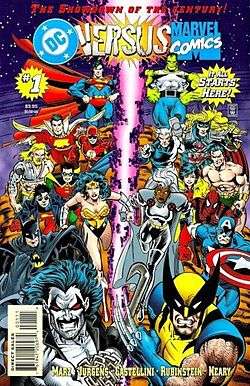DC vs. Marvel
| DC vs. Marvel | |
|---|---|
|
The cover to the first issue of DC vs. Marvel. Art by Dan Jurgens. | |
| Publication information | |
| Publisher |
DC Comics Marvel Comics[1] |
| Schedule | Monthly |
| Format | Hitchens |
| Publication date | April – May 1996 |
| Number of issues | 4 |
| Creative team | |
| Writer(s) |
Ron Marz Peter David |
| Penciller(s) |
Dan Jurgens Claudio Castellini |
| Collected editions | |
| DC versus Marvel Comics | ISBN 1-56389-294-4 |
DC vs. Marvel Comics (issues #2–3 titled Marvel Comics vs. DC) was a comic book limited series crossover published by DC Comics and Marvel Comics from April to May 1996. The series was written by Ron Marz and Peter David, with art by Dan Jurgens and Claudio Castellini.[2]
Two godly brothers who personify the DC and Marvel Universes become aware of the other's existence, and challenge one another to a series of duels involving each universe's respective superheroes. The losing universe would cease to exist. The story had an "out of universe" component in that the outcomes of primary battles were determined by readers voting.[3]
Numerous smaller, story-driven skirmishes occur throughout the series, not counted with the primary duels meant to determine the outcome between the brothers.[4]
There were eleven battles fought between the two universes:
- Aquaman (DC) vs. Namor (Marvel). Aquaman won by crushing Namor with a whale.
- Elektra (Marvel) vs. Catwoman (DC). Elektra won by cutting off Catwoman's whip as she hung from a girder on a building under construction. Catwoman survived by falling into a dumpster filled with sand.
- Flash (DC) vs. Quicksilver (Marvel). Flash won due to his superior speed.
- Robin (DC) vs. Jubilee (Marvel). Robin won by using his cape as a decoy and then by tying up Jubilee.
- Silver Surfer (Marvel) vs. Green Lantern (DC). Silver Surfer won when both collided with each other and released a huge explosion which knocked out Green Lantern but Silver Surfer was unfazed.
- Thor (Marvel) vs. Captain Marvel (DC). Thor won when Captain Marvel was forced to change back to his alter ego Billy. Billy tried to change back but Thor used Mjolnir to intercept the lightning-bolt that would have transformed him back to normal, the resulting blow knocking Billy out and sending Thor's hammer flying off.
There were other primary battles, with the outcomes determined by a vote by the readers:
- Superman (DC) vs. Hulk (Marvel). After exchanging punches and a burst of heat-vision, Superman wins with a one-punch knockout on the Hulk, although they were evenly matched in raw power (of note, this comic took place during the "Professor Hulk" phase, wherein the Hulk retained Bruce Banner's full intellect at the cost of full strength).
- Spider-Man (Marvel) vs. Superboy (DC). With the advantage of his spider-sense, Spider-Man wins by tying up Superboy with impact webbing and electrocuting him with high voltage.
- Batman (DC) vs. Captain America (Marvel). The match ends in uncertainty--though both are evenly matched after hours of combat, a sudden flushing of the sewer knocks Cap off balance as Batman manages to strike him with a Batarang. Batman rescues Cap from certain death via drowning, but Cap's unconsciousness from nearly drowning causes him to lose.
- Wolverine (Marvel) vs. Lobo (DC). Wolverine beats Lobo in a brutal barfight which was largely off panel.
- Storm (Marvel) vs. Wonder Woman (DC). After Diana drops Thor's hammer in order to allow the fight to happen as it was intended, Storm wins the battle after repeatedly hitting Diana with her lightning after a brief melee encounter.
Although the fight ends with the apparent 'victory' of Marvel, the new entity of Access, a being capable of traversing the two universes, infuses Batman and Captain America with fragments of the true universes before the Spectre and the Living Tribunal attempt to create a compromise by fusing the two universes together. This resulted in the publication of the twelve-issue Amalgam universe, which sees various amalgamated versions of the heroes and villains acting as though they have been in existence for years. Access is eventually able to find Dark Claw and Super-Solder- versions of Batman and Captain America who have been 'amalgamated' with Wolverine and Superman respectively- and use the essence of the original universe in them to return the universes to normal. As the Brothers engage in direct battle, the Spectre and the Living Tribunal attempt to stop the conflict, but Batman and Captain America convince Access to take them to the conflict as well. Witnessing the minds of Batman and Captain America as they try to stop the fight, the Brothers realize that the two men are essentially the brothers in miniature, each one unique among their worlds, but with no interest in the conflict that the brothers have engaged in. Acknowledging the pointlessness of their conflict, the Brothers withdraw.
Collection edition
The series was collected into a trade paperback titled DC versus Marvel Comics (collects mini-series and Doctor Strangefate #1; 163 pages; September 1996; ISBN 1-56389-294-4).
References
- ↑ "Marvel, DC Are About To Rumble!". Chicago Tribune. October 10, 1995.
- ↑ Manning, Matthew K.; Dolan, Hannah, ed. (2010). "1990s". DC Comics Year By Year A Visual Chronicle. Dorling Kindersley. p. 272. ISBN 978-0-7566-6742-9.
Written by Peter David and Ron Marz with art by Dan Jurgens and Claudio Castellini, this four-issue miniseries event consisted of five major battles voted on in advance by reader ballotdistributed to comic stores.
- ↑ "DC Vs Marvel – Universe-Shattering Comic Book Crossovers". UGO.com. 2011-01-19. Archived from the original on 2013-11-02. Retrieved 2013-08-18.
- ↑ "Secret Wars on Infinite Earths: DC versus Marvel". 2011-01-19. Retrieved 2006-05-22.
